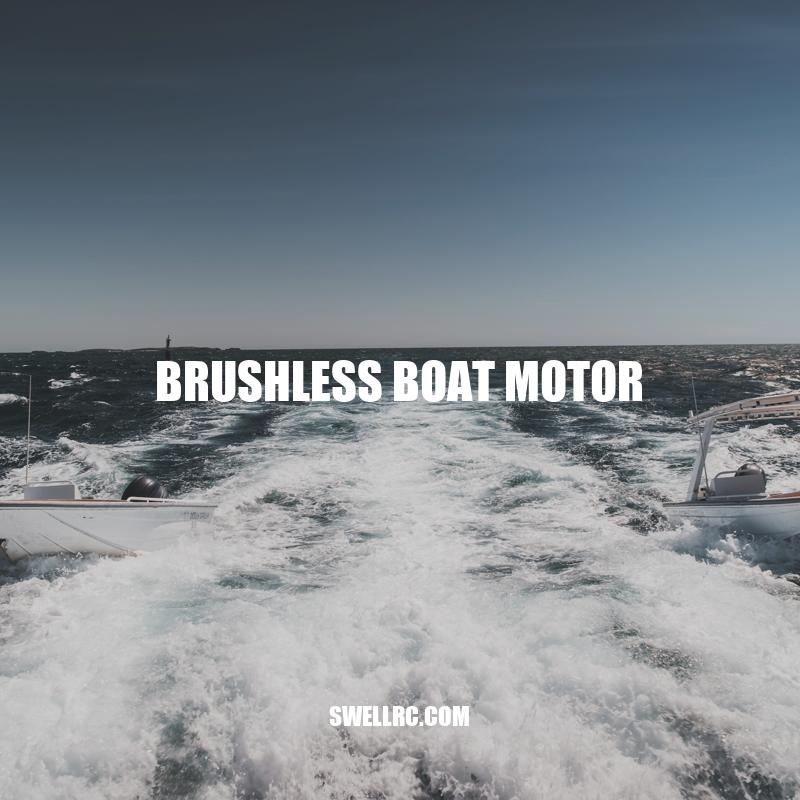Benefits and Working of Brushless Boat Motors
Brushless boat motors are a type of electric motor that has become popular among boat owners due to their many benefits. Compared to brushed motors, brushless motors offer improved efficiency, better performance, reduced maintenance, and a longer lifespan. They also operate much quieter, making them ideal for boating activities that require stealth. These motors work using electromagnetic fields instead of mechanical brushes, which means that they are more robust and last longer. With the right maintenance and upkeep, brushless boat motors are a reliable and hassle-free option that can make your boating experience smoother and more efficient. In this article, we will take a closer look at how brushless boat motors work, their advantages, and what you should consider when choosing and maintaining a brushless motor for your boat.
How Brushless Boat Motors Work
To understand how brushless boat motors work, it’s essential first to know how brushed motors work. The brushed motor consists of two main parts: the rotor and the stator. When the brushed motor is turned on, the electrical current flows from the battery to the commutator, causing the brushes to come into contact with it and create a magnetic field. On the other hand, a brushless motor doesn’t have a commutator, and therefore there’s no need for brushes to come into contact with it. Instead, there are just stators and rotors with permanent magnets installed.
The stator’s core in a brushless motor is made up of large electromagnets that generate a rotating magnetic field, which causes the rotor with the permanent magnets installed to turn. Brushless boat motors use electronic speed controllers (ESCs) to regulate the motor’s speed based on the input signal. This design makes brushless motors more efficient and reliable than brushed motors because they produce less heat and have fewer moving parts. They are also quieter and have a longer lifespan due to less wear and tear and improved heat dissipation.
There are several popular brands of brushless boat motors available on the market. Some of them include ECO-WORTHY, Aquastar, and Amass. If you’re in the market for a new boat motor, consider going with a brushless option for improved performance and longevity.
How does a brushless motor work?
Brushless motors work by using an electronic controller instead of mechanical brushes, which results in smoother operation, less maintenance, and more efficiency. The controller sends power to the motor’s windings in a specific sequence, causing the rotor to turn. This technology is often used in RC vehicles, power tools, and electric cars because of its high power-to-weight ratio. If you want to learn more about brushless motors, you can check out the video on https://www.youtube.com/watch?v=bCEiOnuODac.
Benefits of Brushless Boat Motors
There are many benefits to using a brushless boat motor, including:
- Increased Efficiency: Brushless motors are up to 90% efficient compared to brushed motors, which are only about 75% efficient.
- Reduced Maintenance: Without brushes to replace and no commutator to wear out, brushless motors require less maintenance and have fewer breakdowns than brushed motors.
- Improved Performance: Brushless motors offer a smoother and more precise acceleration making for improved handling and overall boat performance.
- Longer Lifespan: Brushless motors typically last longer than brushed motors because they generate less heat and have fewer moving parts, leading to less wear and tear.
- Quieter Operation: Brushless motors operate more quietly than brushed motors, making for a more enjoyable and peaceful boating experience.
Furthermore, another advantage of brushless motors is that they are equipped with electronic speed controllers (ESCs) that adjust the motor’s speed according to the user’s input. This is made possible due to the brushless technology’s use of sensors that communicate the rotor’s exact position to the ESC, enabling the motor to operate more efficiently. As a result, boats with brushless motors can save power, reducing battery drainage, and maximizing battery life.
Here is a comparison table showing the differences between brushed and brushless motors:
| Brushed Motor | Brushless Motor | |
|---|---|---|
| Efficiency | 75% | Up to 90% |
| Maintenance | Requires periodic maintenance and brush replacements | Requires less maintenance and no brush replacements |
| Lifespan | Shorter due to brushes wearing out | Longer due to fewer moving parts and less wear |
| Performance | Not as precise and smooth as brushless motors | More precise and smoother acceleration |
| Noise | Noisier operation due to brushes making contact with the commutator | Quieter operation with no physical contact |
What are the advantages of a brushless motor?
Brushless motors provide several advantages over traditional brushed motors. They operate at a higher speed and produce more torque, allowing them to provide increased power. Additionally, they are quieter as they don’t rely on brushes rubbing against the commutator. Brushless motors run more efficiently and are less likely to experience power loss due to friction, making them a popular choice for many applications. Overall, brushless motors are reliable, efficient, and produce less noise compared to traditional brushed motors.
Different Types of Brushless Boat Motors
There are two main types of brushless boat motors: inrunners and outrunners. Here’s a breakdown of each:
- Inrunners: Inrunner brushless motors have the stator on the outside and the rotor on the inside. They are designed to produce high RPMs and are typically used in smaller boats or boats that need a high-performance motor. Inrunners are more efficient than outrunner motors but generate less torque.
- Outrunners: Outrunner brushless motors have the stator on the inside and the rotor on the outside. They produce more torque than inrunner motors but are less efficient. Outrunner motors are often used in larger boats and applications where torque is required more than speed.
It’s important to select the appropriate motor type for your boat to ensure optimal performance. Factors to consider when choosing between the two types include weight, size, and propulsion requirements. Another crucial factor is the motor’s Kv rating, which denotes its RPM output per volt. Boats requiring high speed will require a motor with a high Kv rating, whereas those requiring more torque will require a lower Kv rating.
Here are a few additional keywords related to brushless boat motors and their types:
– High-performance motors
– Torque vs. speed
– Propulsion requirements
– Electric boat motor
– Marine electric motor
For a comparison of inrunner and outrunner brushless boat motors, check out the following table:
| Inrunner | Outrunner | |
|---|---|---|
| Stator/Rotor Placement | Stator is outside, and the rotor is inside | Stator is inside, and the rotor is outside |
| Torque | Less | More |
| Efficiency | Higher | Lower |
| RPM Capacity | Higher | Lower |
| Speed Capacity | Lower | Higher |
What is the difference between outrunner and inrunner motors?
Outrunner and inrunner torque motors differ in the positioning of their rotor and stator. In an inrunner motor, the rotor is located inside the stator, while in an outrunner motor, the rotor is located outside the stator. The choice between the two depends on the specific application and its requirements. Some websites sell both types of motors, such as ServoCity and Motion Control Products.
Choosing the Right Brushless Boat Motor
Selecting the right brushless boat motor for your boat involves looking at several specifications, including the motor’s power rating, efficiency, size, and type. Here are some factors to consider:
– Power Rating: Choose a motor that can provide enough power for your boat. The power rating is denoted in watts, and the higher the rating, the more power the motor can deliver. Calculate your boat’s weight and add the weight of any passengers and equipment to determine the power rating you need.
– Efficiency: A motor’s efficiency rating tells you how much power the motor can convert into thrust. Motors with high efficiency ratings will provide better performance and consume less power, giving you longer run times.
– Size: Choose a motor that is the right size for your boat. Motor size is generally determined by the length and weight of the boat. Larger boats require larger motors, while smaller boats can use smaller motors.
– Type: Choose between an inrunner or outrunner brushless motor based on the boat’s size, weight, and speed requirements. An inrunner motor is more efficient but produces less torque, whereas an outrunner motor produces more torque but is less efficient.
– Propeller: Choosing the right propeller is essential to get the best performance out of your brushless boat motor. The propeller’s diameter, pitch, and number of blades all impact how much thrust is generated.
When shopping for brushless boat motors, make sure to do your research and read reviews from other customers. Look for motors that are from reputable brands with warranties and good customer service. Websites like Amazon and West Marine offer a wide range of brushless boat motors to choose from, and they have customer reviews to help you make an informed decision.
Here are a few additional keywords related to choosing the right brushless boat motor:
– Boat weight and length
– Thrust
– Performance and power consumption
– Reputable brands
– Warranties and customer service
– Amazon and West Marine
How to choose a brushless motor for RC boat?
Choosing the right brushless motor for an RC boat largely depends on the size of the boat’s hull. For hulls up to 600mm, a 28-29mm can size motor should suffice. For boats up to 800mm, a 36mm can size motor would work well. If the hull is up to 1200mm and made of a light brushless dedicated or abs material, a 40mm can size brushless motor would be best. However, anything over that size would require a 56-58mm brushless motor. It’s important to remember that the motor should fit the application and the boat’s weight should be taken into consideration. Websites such as HobbyKing offer a wide range of brushless motors that can be suitable for RC boats.
Maintenance of Brushless Boat Motors
While brushless boat motors require less maintenance than their brushed counterparts, it’s still essential to perform regular maintenance to ensure they continue to work optimally. Here are some tips:
- Clean: Keep the motor clean by wiping it down with a damp cloth after each use. Avoid using chemicals that can damage the motor’s components.
- Check for Damage: Regularly inspect the motor for any damage, such as cracks or chipped blades. Replace any damaged parts as soon as possible to prevent further damage.
- Lubrication: Lubricate the motor’s bearings every few months with a silicone-based lubricant to prevent them from seizing up or corroding.
- Tighten Connections: Periodically check and tighten any loose connections, screws, and bolts to prevent vibration and overheating.
- Storage: Store the motor in a dry, cool place when not in use. Protect it from water, dust, and other contaminants that can damage its components. Remove the propeller to prevent any bending or damage during storage.
To keep your brushless boat motor in excellent condition, it’s important to use the right products for maintenance. Some recommended products include silicone-based lubricants, cleaning cloths, and anti-corrosion sprays. You can find these products on websites like Amazon and West Marine.
Here are a few additional keywords related to the maintenance of brushless boat motors:
– Regular maintenance
– Damaged parts
– Lubrication
– Tightening connections
– Storage
– Recommended products
– Anti-corrosion sprays
Do brushless motors need maintenance?
Brushless motors require very little maintenance, but they should be inspected regularly and cleaned to provide optimum performance. This is one of the benefits of brushless motors. There are many resources available online, such as manufacturer websites and forums, where you can find tips on maintaining your brushless motor. In addition, there are products available, such as cleaning solutions and lubricants, that can help keep your motor running smoothly.
Conclusion
Brushless boat motors offer many benefits over brushed motors, such as improved performance, higher efficiency levels, reduced maintenance, longer lifespan, and quieter operation. Understanding how the motor works and how to maintain it correctly is crucial to ensure that your investment in the motor pays off in the long run. When choosing a brushless boat motor, consider the size and type of your boat, power rating, and propeller type to achieve the best performance.
Whether you’re a seasoned boater or new to the hobby, a brushless boat motor can significantly improve your boating experience with its reliable, efficient, and quiet operation. By following the simple maintenance tips discussed in this article, you can keep your brushless motor running smoothly for years and potentially save yourself costly repairs. When purchasing, consider doing a bit of research to find a brushless motor that meets your particular boating needs. Safe boating!



